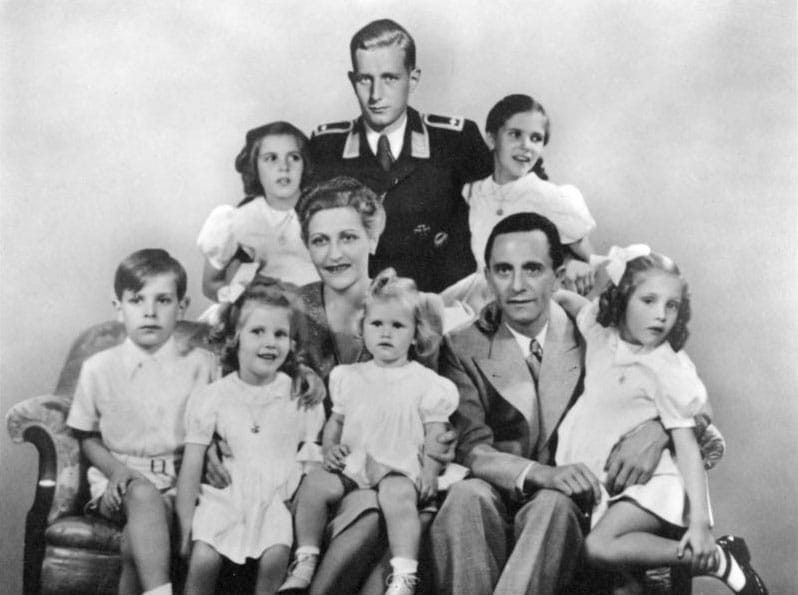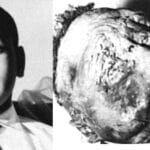Helga Susanne Goebbels, the “golden girl” of Nazi Germany, lived a life entangled with the sinister ideology of the Third Reich. As the daughter of Joseph Goebbels, Hitler’s Minister of Propaganda, her childhood was a jarring juxtaposition of privilege and terror. Adored by Hitler himself, Helga unwittingly became a pawn in her father’s propaganda machine – a symbol of Aryan innocence meant to mask the regime’s brutal reality. Her story, culminating in a horrific tragedy within Hitler’s bunker, offers a chilling reminder of innocence lost amidst the chaos of war and the devastating consequences of unchecked extremism.
Unlocking the Story of Helga Susanne Goebbels: “Hitler’s Favorite Girl”
Helga Susanne Goebbels, born in 1932, was thrust into a world dominated by her father’s influence. Often photographed alongside Hitler, she became known as “Hitler’s Favorite Girl.” While the true nature of their relationship remains shrouded in speculation, the label itself adds a layer of unsettling intrigue to Helga’s already unusual upbringing.
Growing up surrounded by the architects of the Third Reich, Helga became a symbol of the Nazi party’s vision for the future. Her image was meticulously crafted and disseminated through propaganda, showcasing her as the epitome of Aryan virtue. This manipulation of her childhood underscores the insidious ways in which the Nazi regime exploited innocence for political gain.
As World War II raged on, the Goebbels family, along with other high-ranking Nazi officials, sought refuge in the depths of Hitler’s bunker. This wasn’t simply a family seeking shelter from the bombs; it was a group deeply entrenched in the Nazi regime, facing the imminent collapse of their carefully constructed world. On May 1, 1945, with the Allied forces closing in, Joseph and Magda Goebbels made an unimaginable choice, driven by a perverse combination of fear and fanaticism. They took the lives of their six children, including 12-year-old Helga, before ending their own.
The reasons behind this horrific act continue to be debated by historians. Some posit that the Goebbels, so thoroughly indoctrinated in Nazi ideology, viewed death as the only escape from a world that no longer aligned with their twisted worldview.
Life Inside the Goebbels Family: Privilege and Propaganda
The Goebbels children – Helga, Hildegard, Helmut, Holdine, Hedwig, and Heidrun – lived a life that seemed ripped from the pages of a fairytale, yet tragically warped by the sinister reality of Nazi Germany. Imagine growing up in a sprawling mansion, waited on by servants, while the world outside was engulfed in a war orchestrated by your own father. This was the jarring dissonance that defined their childhood.
Joseph Goebbels, the mastermind behind Hitler’s propaganda machine, ensured that his family wasn’t just living a privileged life; they embodied Nazi ideals. The Goebbels children, with their blonde hair and blue eyes, were paraded as the ideal Aryan family, their images plastered across posters and featured in propaganda films.
People’s Statement: Magda’s mother, Auguste Behrend, stated that the family made a hobby of choosing baby names beginning with “H.”
Behind the meticulously crafted smiles and idyllic scenes lay a chilling truth: The family’s privilege was built upon the suffering of millions targeted by the very regime they personified. While the children remained largely shielded from the horrors their father helped orchestrate, Joseph and Magda were deeply entrenched in the Nazi party’s hateful ideology. Magda, a close confidante of Hitler, embraced the Nazi doctrine with chilling conviction, and together, she and Joseph instilled these beliefs in their children.
As the war turned against Germany, the Goebbels family found their carefully constructed world crumbling around them. They fled to the cramped and claustrophobic confines of Hitler’s bunker in Berlin, their desperation palpable in the diary entries Magda kept during those final days. It was here, in the heart of the collapsing regime, that their story reached its tragic climax. Rather than face defeat and the consequences of their actions, they chose to murder their children before taking their own lives.
The Goebbels family story serves as a chilling parable about the seductive power of propaganda and the insidious ways in which ideology can warp even the most fundamental human instincts. It’s a tale that forces us to confront the human capacity for both love and unspeakable cruelty, for nurturing and manipulation.
The Final Days in Hitler’s Bunker: A Timeline of Tragedy
The air within Hitler’s bunker was thick with tension as the Nazi regime teetered on the brink of collapse. The weight of impending defeat, the knowledge of atrocities committed, and the fear of retribution hung heavy in the dimly lit corridors.
Here’s a chilling timeline of those final days in April 1945:
April 20, 1945: Hitler’s 56th birthday. Amidst growing despair and the relentless advance of Soviet forces, a bizarre attempt at normalcy was made. Celebrations were held within the bunker’s confines, perhaps a desperate attempt to cling to a semblance of order as their world crumbled around them.
April 22, 1945: A turning point in Hitler’s mental state. The once seemingly invincible dictator finally acknowledges the inevitability of defeat. The weight of this realization, the shattering of his delusions of grandeur, likely had a profound impact on the already tense atmosphere within the bunker.
April 28, 1945: Betrayal rocks the bunker. Word reaches Hitler that Heinrich Himmler, one of his most trusted officers, has attempted to negotiate a surrender with the Allies. This act of treason fuels paranoia and triggers a wave of executions within the bunker’s hierarchy.
April 29, 1945: In a surreal turn of events, Hitler marries Eva Braun in a small ceremony within the bunker. This marriage, born not of love but perhaps of defiance or a desire for a sense of normalcy amidst chaos, is quickly followed by Hitler finalizing his last will and testament.
April 30, 1945: The Nazi regime reaches its horrific end. Hitler and Eva Braun commit suicide within the bunker, choosing death over capture.
May 1, 1945: The tragedy continues. Joseph Goebbels, Hitler’s Minister of Propaganda, and his wife, Magda, poison their six children, including Helga, before taking their own lives.
May 2, 1945: Silence falls upon the bunker as Soviet troops finally break through, capturing the site and bringing the Battle of Berlin to a definitive end.
The story of Hitler’s bunker is not merely a historical footnote; it’s a chilling cautionary tale about the perils of unchecked power, the seductive nature of propaganda, and the depths of human cruelty.
The Death of Helga Goebbels: Murder-Suicide or Struggle?
Helga’s story takes a particularly heartbreaking turn as the war tightens its grip on Berlin. The once vibrant city, now reduced to rubble, becomes a desperate battleground. The Goebbels family, accustomed to a life of privilege and power, find themselves trapped within the Führerbunker, a last-ditch attempt at safety as their world crumbles around them.
It was within this environment of fear and uncertainty that Helga and her siblings became tragic victims of their parents’ twisted ideology. Surrounded by fanaticism, they were indoctrinated with Nazi beliefs from a young age, their young minds ill-equipped to fully grasp the horrors unfolding around them.
On May 1, 1945, as the Red Army closed in and the sounds of battle echoed through the bunker, Joseph and Magda Goebbels made an unconscionable decision. They chose to end their children’s lives rather than subject them to a world without Nazi rule.
The exact details surrounding Helga’s death, like those of her siblings, remain shrouded in speculation and historical debate. The generally accepted account is that she was given a cyanide capsule, like her siblings. However, some accounts suggest that Helga may have resisted her parents’ horrific plan. Post-mortem examinations revealed bruising on her body, hinting at a possible struggle, a desperate fight for life against the very people who were supposed to protect her.
The question of whether Helga’s parents truly believed they were committing an act of mercy or whether their actions were driven by cold, calculated fanaticism continues to haunt historians. Did they genuinely believe they were shielding their children from a fate worse than death, or were their actions driven by a perverse sense of ownership over their children’s lives? This chilling ambiguity is a stark reminder of the moral abyss that can engulf individuals and nations consumed by war and extremism.
Helga Goebbels’s Legacy: Remembering a Child Victim of Nazism
Helga Goebbels’s life, though tragically cut short at the age of twelve, holds a significant place in history. Born into the heart of the Nazi regime, she became both a symbol of its propaganda machine and ultimately, a victim of its horrific ideology.
Her story serves as a chilling reminder of the human cost of war and the devastating impact of extremism, particularly on the most vulnerable members of society. Helga’s tragic fate underscores the importance of protecting children from the manipulation of hateful ideologies and the need to safeguard innocence amidst conflict.
The unsettling fascination with Helga’s story stems in part from the way in which the Nazi regime used her image. The Goebbels family, with their six blonde-haired, blue-eyed children, were presented as the epitome of Aryan perfection, embodying the Nazi’s vision for a “master race.” Photos of Helga and her siblings were frequently used in propaganda campaigns, aiming to project an image of normalcy and wholesomeness, masking the regime’s true nature.
This manipulation of Helga’s image underscores the insidious power of propaganda and the importance of critical thinking. It serves as a reminder of the need to question narratives, particularly during times of conflict when those in power often exploit fear and manipulate information for their own ends.
While details of her short life remain shrouded in historical debate, Helga’s legacy lives on as a potent symbol of the enduring need to learn from the darkest chapters of history. Her story compels us to confront the consequences of unchecked hatred, the seductive nature of extremist ideologies, and the importance of protecting the vulnerable from manipulation and exploitation. More than just “Hitler’s Favorite Girl,” Helga Goebbels stands as a stark reminder of the human cost of intolerance and the enduring need to strive for a more just and compassionate world.
- Get all the updates and biography of the famous couple, howard hughes and katharine hepburn, here.
- Alexandre de Beauharnais is a politician and military leader who left an impact on the history of France.
- Find out the story behind the young man who hid from the Nazis, August Van Pels, in the Secret Annex along with the Frank family.
- Learn about one of the famous Celtic Queens, Iceni Boadicea.
- Know more about the haunting details and uncovered facts of the tragic Emmett Till Death Pictures.
- Explore the chilling details and impact of the infamous serial killer, Jack The Ripper Victims Photos.
- Unlock Elemental 2 Secrets: Actionable Insights Now - April 2, 2025
- Lot’s Wife’s Name: Unveiling the Mystery of Sodom’s Fall - April 2, 2025
- Photocell Sensors: A Complete Guide for Selection and Implementation - April 2, 2025
















